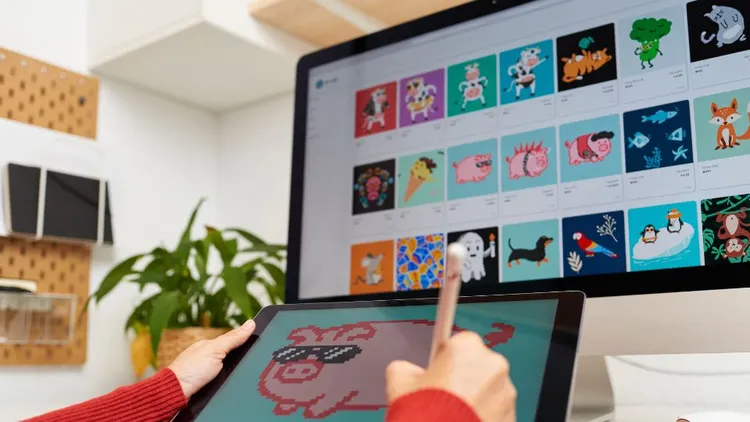

Digital products have exploded in popularity in recent years as more consumers and businesses shift online. Creating and selling digital goods can be an excellent way to monetize your knowledge and skills to generate steady passive income. But with so many digital products already available, how can you create offerings that stand out and attract eager buyers in 2024?
The key is to identify what digital products are currently in high demand, understand the different types of products you can create, and follow proven steps to develop and launch your product. Fortunately, with the right strategy and tools, just about anyone, even with limited technical skills, can create profitable digital products.
Whether you’re an entrepreneur, freelancer, blogger, educator, or creator looking to diversify your income, this comprehensive guide will show you how to brainstorm, create, and sell digital products poised to be big hits in 2024 and beyond.

First, let’s clarify what we mean by “digital product.” A digital product is any good or asset created, delivered, and used in a digital format. Unlike physical products, digital products don’t require inventory, packaging, or shipping. They exist as downloadable or streamable files that customers can instantly access upon purchase.
Some common examples of digital products include:
The key advantages of digital products are:
You create the product once and can sell it unlimited times.
The #1 to make money online with TikTok Search (FREE TRAINING)

If you’re new to creating digital products, you may wonder what type of product is the simplest to start with. While the answer depends on your specific skills and niche, some of the easiest digital products for beginners tend to be:
The easiest digital product for you will be one that leverages your existing knowledge and skills. Focus on extracting your expertise into a simple, downloadable format, and take your time creating a massive product right away. Start small, learn the process, and improve and expand your products over time.
Let’s dive deeper into some of the most popular and profitable types of digital products you can create, with real-world examples of each to inspire your own digital product ideas.
Ebooks continue to be one of the most popular digital products year after year. Whether it’s a non-fiction how-to guide, educational handbook, or fictional novel, there is a large market for ebooks across all genres and topics.
Self-publishing ebooks can be quite lucrative. For example, freelance writer Carol Tice has earned over $45,000 from self-publishing 10 short ebooks teaching freelance writing tips.
Other profitable ebook ideas include:
You can sell ebooks on your own website and on popular ebook marketplaces like:
To complement your ebooks, consider creating audiobook versions. The audiobook market continues to surge, growing by 25% in 2021 alone. You can narrate the audiobook yourself or hire professional narrators through freelance marketplaces like Upwork or ACX. Selling audiobooks expands your product offerings and caters to those who prefer listening over reading.
For an all-in-one platform to host and sell your ebooks and audiobooks, consider using Teach.io. With Teach.io, you can easily upload your files, set your price, and start selling under your own brand. Their built-in community features also allow you to build an online group or book club around your book to engage readers and drive referral sales. Sign up for a 14-day free trial of Teach.io to get started.

Online education is a massive and fast-growing market. The e-learning industry is set to reach over $300 billion annually by 2025 as more students turn to online courses to gain new skills. Creating an online course teaching something you’re an expert in is an ideal way to monetize your knowledge and help others.
Online course ideas are endless and span a wide variety of subjects, such as:
Some creators have built six and seven-figure businesses selling online courses:
To create and sell an online course, you’ll need to:
Online courses cost from $20 to $2000+, depending on the depth of content and results provided. They continue to be one of the most lucrative and in-demand digital products.
To maximize your course sales, consider hosting it on Teach.io. Beyond providing a powerful course builder and hosting, Teach.io also enables you to create a unique community experience for your students. You can host group coaching calls, mastermind sessions, and live Q&As and facilitate student discussions all within the platform. This allows you to charge premium prices for your course and generate recurring revenue. Plus, their affiliate features make it easy to enlist partners to promote your course for you.
Creating visual templates and website themes can be very profitable if you have an eye for design. Small business owners, bloggers, and creatives always need professional, attractive visual assets and are willing to pay for them.
Some in-demand template and theme ideas include:
Graphic designer Dustin Lee grew his digital product business, Retro Supply Co, to over $200,000 in revenue by selling templates, fonts, graphics, and effects to other designers.
You can sell your templates and themes on your own using tools like Sellfy and SendOwl, or tap into existing marketplaces like:
The key with templates and themes is to create unique, eye-catching designs that aren’t readily available for free. Consider creating template bundles or membership sites to generate recurring revenue.
To speed up development, design your templates and themes using Canva, then host them on Teach.io. This combination makes it quick and simple to create professional products and deliver them securely to customers. You can even use Teach.io to run a paid membership site or design agency, providing new templates and themes to subscribers each month. Their built-in community and messaging features make it easy to provide support and engage with your customers so they stick around long-term. Try it out free for 14 days.
The rise of content marketing has led to an insatiable demand for stock photography and videos. Bloggers, marketers, and businesses need a constant stream of high-quality visual content and are happy to pay for it to save time and effort.
If you’re a skilled photographer or videographer, you can monetize your work by selling it as stock imagery. You likely already have a large library of photos and footage on your hard drive to turn into digital products.
In-demand stock imagery includes:
Stock photographer Elijah Hiett has earned over $15,000 in his highest-earning months licensing his photos through stock imagery sites. Top videographers can earn hundreds of thousands per year.
Popular stock imagery marketplaces to sell your photos and videos include:
To sell stock imagery successfully, you need to upload a large number of high-quality photos and videos that are correctly tagged and categorized. The more niche and specific your imagery is, the more it will stand out.
Sell your stock imagery directly to buyers using Teach.io for the ultimate control over your licensing and pricing. You can create your own stock photo or video site, set your own rates, and build a subscriber base that purchases from you each month. Teach.io protects your files from unauthorized sharing, and its payment processing makes transactions seamless.
Graphic designers, illustrators, and digital artists can generate passive income by selling their artwork and designs as digital products. Digital art sales have exploded in recent years, and the global art market is expected to hit $9.32 billion by 2024.
Some high-demand digital art and design products are:
Artists can earn anywhere from a few hundred to tens of thousands monthly selling digital art. For example, designer Ian Barnard earns over $10,000 monthly selling hand-drawn fonts, icons, and brushes.
To sell your digital art and designs, set up an e-commerce store on a platform like Shopify or WooCommerce and embed digital product delivery software like FetchApp or Easydigitaldownloads. Or sell through creative marketplaces like:
Focus on creating original, stand-out work in your signature style and build up a cohesive product catalog over time to attract collectors and loyal customers.
Teach.io is an ideal platform for artists, as it allows you to create both an online store and an exclusive collector’s community. You can host livestreams, AMAs, and critiques with your top supporters, increasing the value of your art and driving more sales. Their unlimited storage and image protection features are also ideal for creative products.

We’ve covered some of the most popular digital product categories, but which ones have the most market demand and earning potential as we head into 2024? Let’s explore a few of the most promising and profitable digital product ideas.
Online education continues to surge in the wake of the pandemic. People are hungry to learn new skills and hobbies from the convenience of their homes.
Some of the most in-demand and lucrative educational digital products are:
The e-learning market is set to exceed $375 billion by 2026. Analysts predict the most popular online course topics over the next few years will be in categories like:
Online course creators are earning seven figures teaching everything from watercolor painting to Python programming to puppy training. To capitalize on this trend, consider what skills and knowledge you have that others would find valuable and package it into an educational digital product.
Printables and other “low-content” digital products have become popular in recent years. These products provide tremendous value to buyers but take minimal time to create.
Some of the most popular printables and low-content digital products include:
Printables are relatively quick and easy to make with free tools like Canva, Google Slides, or PowerPoint. They have mass market appeal. Consumers from all walks of life use printables to organize their lives, learn, and have fun. Michelle Rohr, the founder of Simplify Days, went from zero to $52,000 a month selling printable planners and organizational templates. Rachel Jones makes over $10,000 per month selling printable sewing patterns.
To get started selling printables, brainstorm ideas for printable products that would help people in your niche achieve a goal or solve a problem. Aim for simple, practical products that provide real value and can be created relatively quickly.
Use Teach.io to host your printables and build a monthly subscription product or membership site around them. Their platform is fantastic for delivering digital downloads and cultivating a community experience that keeps members engaged and paying month after month. They even offer a done-for-you migration service to transfer your existing printables business to Teach.io so you can take advantage of their advanced features and higher payouts. Sign up for your 14-day free trial now.
The global software market is massive and continues to grow each year. In 2022, the worldwide software market was valued at over $593 billion. As digital transformation accelerates, the demand for new software and digital tools is expanding rapidly.
Some profitable software and app ideas are:
Surging categories in the software space include AI, no-code development, blockchain and cryptocurrency, augmented reality, and the creator economy.
While developing software was once only in the realm of programmers, today, it’s possible for non-technical creators to develop profitable software and apps using no-code tools like Bubble and Adalo. You can also hire developers to build your software idea using freelance sites like Toptal or Upwork.
Ben Chestnut and Dan Kurzius grew Mailchimp from a small side project into a $12 billion email automation platform. And John Maeda created Notion, a no-code app builder now valued at $10 billion.
To succeed with software and apps, focus on building tools that solve a clear problem, are simple and intuitive to use, and provide ongoing value to justify the cost.

Now that we’ve explored some of the most promising digital product types and ideas, let’s walk through the process of actually developing and launching your own product.
Before investing significant time into creating a digital product, it’s important to validate that there is a real market need and demand for it. You don’t want to waste effort developing something no one actually wants.
Start by doing market research:
Look for signs that people are already buying similar products in your space and that you can offer a unique angle or improvement over what exists. If you’re having trouble finding products similar to your idea, there may be a reason-the market might be too small, or the product may not be viable.
Aim to get at least a few pre-sales or email sign-ups before creating your product to confirm demand. You can also start lean and create a small MVP (minimum viable product) before expanding your idea.
Once you’ve validated your idea, map out the full scope of your product. What components and content will be included? What problem does it solve, and what results does it deliver? How long will it take to create?
Create a full outline of the chapters and lessons for an ebook or course. For software, mockup each feature and screen. For printables or digital art, sketch out the various templates and designs you’ll include.
Establish your project timeline and plan out each stage of development. Identify what resources and tools you’ll need and if you require assistance like graphic design, video editing, etc. Set a realistic launch date based on the size of your product and stick to your production schedule.
The #1 to make money online with TikTok Search (FREE TRAINING)

With your product fully planned, it’s time to get to work and actually create it! This is where the bulk of your time and effort will be expended.
Some tips to streamline the product creation process:
Continue pushing forward until you have a completed product, even if it’s not flawless. It’s more important to launch and start getting real feedback than to endlessly strive for perfection.
To sell your product, you’ll need to set up your sales funnel and payments. Your exact sales system will depend on your product type and price point.
Some common components of an online product sales system include:
You can create your sales funnel and take payments on your own website using tools like Teach.io, Teachable, Thinkific, SamCart or ThriveCart. Or sell through existing marketplaces like Udemy, Etsy or Gumroad which have built-in payment processing and delivery.
Take time to write compelling sales copy, create attractive visuals, and record an engaging sales video to convince visitors to purchase. Incorporate scarcity with limited-time bonuses or discounts to nudge hesitant buyers.
With your product and sales system ready, it’s time to launch! Orchestrate a multi-channel launch campaign to drive traffic and generate buzz.
Some effective strategies to market your digital product:
Getting your offer in front of the right people is key. Focus on attracting your target customers through the marketing channels where they already congregate.
Give your initial launch a big push and closely monitor your sales and conversion metrics. Continue to tweak your funnel, pricing, and messaging to optimize your revenue.
Your work is just beginning after your initial launch. Collect feedback from your first buyers to identify areas for improvement. Look for opportunities to enhance your product with bonus material, new features, or updates based on customer input.
To scale your sales, consider expanding into additional marketing and traffic channels. Can you reach international audiences? Break into new submarkets? Sell business-to-business?
Boost your average customer value by offering complementary upsells, cross-sells, and subscription products. The more revenue you can generate per customer, the more you can reinvest in marketing to acquire new buyers.
Automate and outsource parts of your sales process to save time as your business grows. Building a team or network of partners can help you take your product to the next level.

One of the advantages of digital products is they are relatively simple to create even without deep technical skills. By leveraging the right tools and software, you can streamline the product creation process and create professional offerings.
Some popular tools for digital product creation include:
With the rise of AI technology, creators can now take advantage of AI-powered tools to speed up the product development process and inject new creative ideas.
Some innovative AI tools for digital products include:
AI tools can help you rapidly generate content, marketing copy, images, videos, and even parts of your software – saving you time and ideation energy. While AI can’t replace human creativity yet, it can help augment the product creation process.
When selecting digital product tools, look for ones that are user-friendly, integrate with your existing tech stack, and are efficient and well-rated. Don’t be afraid to invest in quality software that will make your life easier in the long run.
Digital products may have higher profit margins and scalability than physical goods, but succeeding with them still takes focus and persistence. With so many products already on the market, creating something unique and valuable that serves a real need is essential.
To recap, here are the key steps to create profitable digital products in 2024:
The key to success is delivering a quality product and customer experience. Stand behind your products and strive to create something you’re proud of.
Remember, you don’t need to be a coding genius or have a huge launch budget to get started with digital products. Start small with a simple MVP to test the waters. Then, reinvest your profits to level up your products and marketing over time. The process can sometimes feel overwhelming, but the rewards of generating income independently by doing something you enjoy is worth the effort.
If you want an all-in-one digital product creation and hosting solution, consider using Teach.io. Teach makes it easy to build online courses, digital downloads, and membership sites under your own brand. You can set up payments, embed checkout forms on your site, drip your content, and handle customer communication all from one dashboard.
So what are you waiting for? You can even use Teach.io to presell your software idea, validate demand, and fund development by offering exclusive beta access to founding members. Then continue to host your user community on Teach.io after launch to provide support, gather feedback, and upsell additional products and services. Their built-in forum and chat features make it easy to communicate with your software users so you can continue improving your product. Claim your free 14-day trial of Teach.io to get started.





